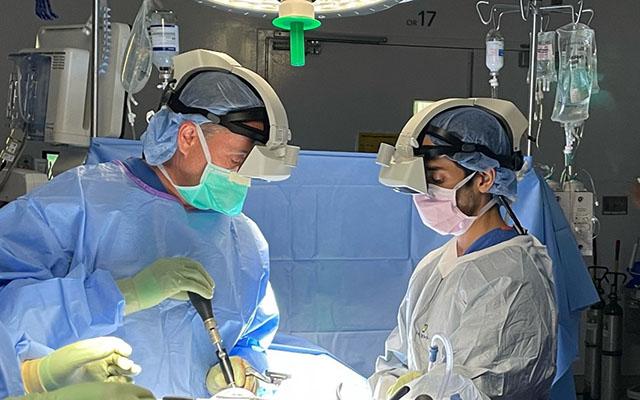Augmented reality headsets give spine surgeons ‘X-ray vision’ during procedures for accurate and personalized implant placement, while keeping their eyes on their patients

Credit: UC San Diego Health Sciences
Spine surgeons at UC San Diego Health are the first on the West Coast to begin using a form of augmented reality in their practice. The three-dimensional navigation system and headset allow surgeons to “see” inside the body, helping them quickly and accurately place implants in each patient’s unique anatomy. This system, first used by the health system on April 1, 2021, lets surgeons maintain their focus directly on the patient, rather than on a distant screen displaying the patient’s CT scans.
Richard (Todd) Allen, MD, PhD, was the first orthopedic surgeon to use the system at UC San Diego Health. For him, the technology is like an advanced car navigation system — except instead of looking back and forth between the car’s screen and the road, the directions are superimposed on to the road ahead. Without the augmented reality headset, surgeons rely on feel, X-ray and CT images taken throughout the procedure.
The first time Allen used augmented reality was during a complicated spinal fusion procedure in which multiple vertebrae were brought together and stabilized with two rods and several screws. Allen said he and the operating team, which included Spine Fellow Paul Bagi, MD, were able to accurately place the screws in approximately half the time it would normally require.
“Less time in the operating room typically means less blood loss, lower risks of related complications, and the potential for a more rapid recovery,” Allen said. “Of course, saving time should never be at the expense of safety. But with this technology, we can decrease operative time while actually improving safety. My focus is to align the goals of spine surgery with those of each patient, so they receive personalized care. I strive to treat each patient as an individual, and understand what they want to get out of their surgery.”
The system consists of a headset with a transparent near-eye-display and navigation technology to determine the position of surgical tools in real-time and superimposes them on the patient’s CT scan image. The information is projected onto the surgeon’s retina using the headset, allowing the surgeon to simultaneously see the patients’ unique spinal anatomy from the side, the top and in three dimensions, with software allowing them to recreate the same trajectory for each tool used and during screw placement.
Allen also looks forward to incorporating the technology in his teaching. As the region’s only academic health system, many residents and fellows spend their first few years as physicians training at UC San Diego Health.
“Normally, residents and fellows can only see what my hand is doing,” he said. “Now they’ll be able to see the patient’s spine as well, the trajectory of an instrument within the spine in real time, and then understand why I might choose to place a screw the way I do, for example. And they’ll be able to see exactly how to adjust as we go, depending on the patient’s unique anatomy.”
Manufactured by Augmedics, the xvision Spine System headset is currently approved for use in open and minimally invasive spine implant procedures. These types of procedures are intended to treat a variety of conditions, including herniated discs, scoliosis, spinal fractures and spinal tumors.
Back and neck pain are among the most common reasons for a doctor’s visit, but they don’t always require surgery. UC San Diego Health’s spine specialists, physiatrists and anesthesiologist are skilled in diagnostic care and surgical and nonsurgical treatment options. UC San Diego Health is nationally ranked in orthopedics by U.S. News & World Report and recognized as a Center of Excellence for complex spine care by Optum and is designated a Blue Cross-Blue Shield Center of Distinction for Spine Surgery.
“I worry that many people are unnecessarily living in pain because they fear they may need surgery, or because they’ve put off seeing a doctor during the COVID-19 pandemic,” Allen said. “But it never hurts to discuss your options with a spine expert — and now is a great time to do it.”
UC San Diego Health has implemented extra safeguards to protect patients and staff during the COVID-19 pandemic, including universal masking, distancing in reception areas and symptom screening for all patients, staff and visitors. In many cases, video visits are available to help reduce person-to-person contact. All patients are tested for COVID-19 before surgery and hospital admission.
###
For more information or to schedule an appointment, please visit health.ucsd.edu/orthopedic-spine.
Media Contact
Heather Buschman, PhD
[email protected]




